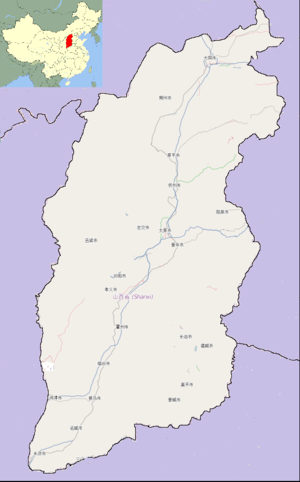Taiyuan
Taiyuan (Chinese: 太原; pinyin: Tàiyuán [tʰâi.ɥɛ̌n], also known as Bīng (并), Jìnyáng (晋阳)[2]) is the capital and largest city of Shanxi province in China.[3] It is one of the main manufacturing bases of China. Throughout its long history, Taiyuan was the capital or provisional capital of many dynasties in China, hence the name Lóngchéng (龙城; Dragon City).[4]
Etymology and names
The two Chinese characters of the city's name are 太 (tài, "great") and 原 (yuán, "plain"), referring to the location where the Fen River leaves the mountains and enters a relatively flat plain. Throughout its long history, the city had various names, including Bīngzhōu (并州) (from which the city's abbreviated single-character name Bīng (并) is derived), Jìnyáng (晋阳) and Lóngchéng (龙城).
During the Tang dynasty and subsequent Five Dynasties, the status of the city of Taiyuan was elevated to be the Northern Capital, hence the name Běidū (北都), and Běijīng (北京, different from present-day Beijing).[5]
History
Taiyuan is an ancient city with more than 2500 years of urban history, dating back from 497 BC. It was the capital or secondary capital (陪都, 别都) of Zhao, Former Qin, Eastern Wei, Northern Qi, Northern Jin, Later Tang, Later Jin, Later Han, Northern Han. Its strategic location and rich history make Taiyuan one of the economic, political, military, and cultural centers of Northern China.[4]
Pre-Qin dynasty history
From about 859 BC the area around modern-day Taiyuan was occupied by the Rong people. In 662 BC the Rong were driven out by the Di people.[6]
During the Spring and Autumn period, the state of Jin emerged to the south of Taiyuan. In 541 BC, the Jin army led by General Xun Wu (荀吴), drove out the Di Tribes, and Taiyuan became part of the state of Jin.
In 497 BC, the first ancient city of Jinyang was built around the southern Jinyuan District of present-day Taiyuan, by Dong Anyu (董安于), who was a steward of Zhao Jianzi (赵简子, 赵鞅), an upper-level official of the state of Jin.,[4][7]
During the Battle of Jinyang in 453 BC, Zhi Yao (智伯瑶) diverted the flow of the Fen River to inundate the city of Jinyang, caused significant damage to the Zhao. Later, Zhao Xiangzi (赵襄子) alerted Wei and Han, who both decided to ally with Zhao. On the night of May 8, 453 BC, Zhao troops broke the dams of the Fen River and let the river flood the Zhi armies, and eventually annihilated the Zhi army, with the help from Wei and Han.[8]
After the Tripartition of Jin in 403 BC, the state of Jin, then a strong power in Northern China, was divided into three smaller states of Han, Zhao and Wei. Jinyang, was chosen as the capital of Zhao, by Zhao Ji. Later, the capital of Zhao was moved to Handan (邯郸).
Qin dynasty
In 248 BC, the state of Qin attacked Zhao under General Meng'ao, and obtained the area around Jinyang from Zhao. Qin set up the Commandery of Taiyuan (太原郡), with the city of Jinyang as its administrative center. Although, the name Taiyuan had appeared in historic records before, potentially referring to different regions in nowadays southern and central Shanxi, this was the first time Taiyuan was officially used to refer to present-day Taiyuan.[6]
In 246 BC, there was an uprising in Jinyang, and it was quickly quelled by Meng'ao.
In 221 BC, Qin conquered the rest of China, and officially started the first imperial dynasty of China. Qin established thirty-six commanderies on its territory, and Taiyuan was one of them. Also, the capital of commandery of Taiyuan is Jinyang.[9]
Han dynasty and Three Kingdoms
In 206 BC, Emperor Gaozu Liu Bang established the Han dynasty. During that period, the Qin administrative system of commanderies was abolished, the two Commanderies of Taiyuan and Yanmen were combined as the vassal state of Han (韩国) under the rule of King Xin of Han (韩王信).
Later, King Xin of Han moved the capital from Jinyang to Mayi (present-day Shuozhou) with the approval from the emperor Gaozu. However, King Xin of Han conspired with the Xiongnu against Gaozu, and attacked Han for many years. In 196 BC, King Xin of Han was killed after he lost a battle. And the vassal state of Han was replaced by the vassal state of Dai, with Jinyang as the administrative center of Dai.
During the tumultuous Three Kingdoms, the population of Taiyuan decreased significantly due to constant warfares. Taiyuan was ruled by Gongsun Zan, Yuan Shao, and then by Cao Cao, and was part of Cao Wei afterwards.
Jin dynasty and Sixteen Kingdoms
During the Jin dynasty, Taiyuan was again changed into a vassal state. Following the ending of the Jin dynasty, ethnic minority peoples settled a series of short-lived sovereign states in northern China, commonly referred to as Sixteen Kingdoms. Taiyuan was part of Former Zhao, Later Zhao, Former Qin, Former Yan, Former Qin again, Western Yan, and Later Yan chronologically.
In 304, Liu Yuan founded the Xiongnu state of Former Zhao, whose army raided the area around Taiyuan for years and eventually obtained Taiyuan in 316. In 319, Taiyuan became part of Later Zhao, founded by Shi Le. Later, Taiyuan was obtained by Former Yan in 358, and by Former Qin in 370. Former Qin was founded by Fu Jian (苻坚) in 351 with capital of Chang'an.
Fu Jian died in 384. His son Fu Pi declared himself an emperor in 385, with Jinyang (central city of Taiyuan) as the capital. But the next year, Fu Pi was defeated by the Western Yan prince Murong Yong in 386, and Taiyuan became part of Western Yan. In 394, Taiyuan was conquered by Later Yan army.
Southern and Northern Dynasties

In 386, Tuoba Gui founded Northern Wei. In 396, Northern Wei expanded to Taiyuan.
In 543, Eastern Wei was founded by Gao Huan, with the capital at the city of Ye, and Taiyuan as the alternative capital (别都), where the Mansion of the "Great Chancellor" Gao Huan (大丞相府) was located.
In 550, Northern Qi was founded by Gao Yang, who maintained his father Gao Huan's choice of Taiyuan as the alternative capital. The Buddhist Tianlongshan Grottoes of Taiyuan started during this period, and continued for many centuries afterwards.
In 577, Taiyuan was conquered and became part of Northern Zhou.
Sui dynasty
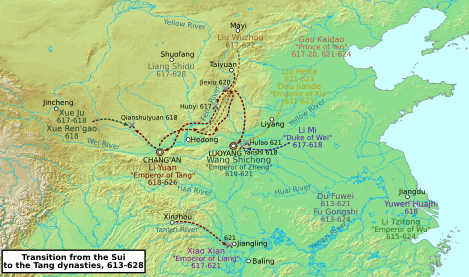
In 581, Emperor Wen of Sui founded Sui dynasty. Jinyang was first the administrative center of Bing Zhou (并州), which was changed into Taiyuan Commandery. In 617, Li Yuan rose in rebellion based in Taiyuan, and expanded quickly.
Tang dynasty
In 618, Li Yuan founded Tang dynasty, which is generally considered a golden age of Chinese civilization. Taiyuan expanded significantly during the Tang dynasty, partly because Taiyuan was the military base of the founding emperors Li Yuan and Li Shimin. As Li Shimin wrote in 619: "Taiyuan, the base of the imperial regime and the foundation of the state." (太原,王业所基,国之根本)[10]
In 690, Wu Zetian set Taiyuan as the Northern Capital, (Beidu, 北都), one of the three capitals, along with Chang'an and Luoyang, as depicted in the poem by Li Bai: "The king of the heaven has three capitals, the Northern capital is one of them."("天王三京,北都居一").[5] In 742 AD, Emperor Xuanzong of Tang changed further to Beijing (北京). During Tang Dynasty, the title Northern Capital to Taiyuan had been endowed or abolished multiple times.[9]
Five Dynasties
In 923, Li Cunxu, son of Li Keyong, founded Later Tang with capital of Daming, and soon conquered most of North China, and ended Later Liang. Afterwards, Li Cunxu moved the capital from Daming to Luoyang, and Taiyuan was set as a provisional capital, titled "Beijing" (Northern Capital).
In 936, Shi Jingtang established Later Jin in Taiyuan with the help from Khitan Liao dynasty. The next year, Shi Jingtang moved the capital from Taiyuan to Luoyang, and then to Kaifeng, and Taiyuan became a provisional northern capital ("Beijing") again.
Song dynasty
Zhao Kuangyin (Emperor Taizu of Song ) established the Song dynasty and embarked on the campaign of re-unification of China. Using a power struggle at the Northern Han court Taizu moved against it in the late 968.[11] By early 969 his armies encircled Taiyuan and defeated the reinforcements sent by the Khitan. However, an attempt to flood the city failed. The siege was lifted after three months, as heavy rains caused diseases in the besieging army, the supplies were running low, and another Khitan relief force was advancing towards the city.[11]
Taizu launched the second invasion of Northern Han in September 969, but the armies were recalled after his death (November 14,969).[11]
Taizu’s brother Taizong subjugated the last independent kingdoms in the south of China by 978, and in 979 launched the third campaign against the Northern Han and its overlord the Khitan state of Liao. Using the north-western route instead of the southern (used in the previous campaigns) the armies of Taizong defeated a major Liao force. Isolated, the Northern Han resisted for only fifteen days before surrendering. In contrast to the mild policies of his brother, Taizong dealt harshly with the city. He ordered the flooding of Taiyuan by releasing the Fen River, and set the city on fire.[11] The former capital was downgraded from the prefecture to county town status.
It was not until 982 that a new city was founded on the banks of the Fen River.[12] The oldest existing building in Taiyuan today is the Temple of the Goddess (simplified Chinese: 圣母殿; traditional Chinese: 聖母殿) inside the Jin Ci Complex. It was originally built in 1023 and reconstructed in 1102.
From 1027 one of the two private markets for Tangut goods, particularly salt, operated in Taiyuan.[13] During the Song period many people, including the family of Wang Anshi, migrated south.[14]
Jin dynasty
The Jurchen Jin dynasty was founded in 1115, and in 1125, Taiyuan was conquered by Jin. The same year, after the conquest of North China by Jin, the capital of Song was shifted to Lin'an, which marked the end of Northern Song, and the start of the Southern Song dynasty.
Yuan dynasty
The Mongol empire emerged in 1206 under the leadership of Genghis Khan, and it expanded quickly. In 1218, Taiyuan was conquested by the Mongol army led by General Muqali. Kublai Khan established the Yuan dynasty in 1271, and the administrative area of Taiyuan Lu (太原路) was expanded.
The Taoist Longshan Grottoes was built in early Yuan dynasty, initiated by Taoist monk Song Defang (宋德芳).
Ming dynasty
In 1368, Zhu Yuanzhang established the Ming dynasty, and Taiyuan was obtained from Yuan, by General Xu Da.
The Ming dynasty installed Nine Military Garrisons to defend the northern territory during the reign of the Hongzhi Emperor, which included the Garrison of Taiyuan (太原镇).
Shanxi merchants became prominent in Chinese business history since the beginning of Ming dynasty, thanks to the logistic requirements of the military around the borders of northern Shanxi to defend Ming against the remnant Mongol Northern Yuan dynasty.
In the ending period of Ming dynasty, the rebel leader Li Zicheng conquered Taiyuan, and Taiyuan became part of Great Shun temporarily in 1644.
Qing dynasty
In 1644, Shunzhi founded the Qing dynasty and defeated the Great Shun Army in Taiyuan in the same year.
Throughout the Qing dynasty, the international trade with Russia, especially of tea, and the creation and development of so-called draft banks, or Piaohao, boosted the central Shanxi basin to become the financial center of Qing China. Even though most of these Piaohao were based in different neighboring counties of Qi County, Taigu, and Yuci, Taiyuan became a significant trading center, due to its political and economical status in Shanxi. [15][16]
In 1900, the Taiyuan Massacre occurred, during which a number of Western missionaries were killed.[17]

Republic of China
The warlord Yan Xishan retained control of Shanxi from the Xinhai Revolution in 1911 to the end of the Chinese Civil War in 1949. Taiyuan consequently flourished as the center of his comparatively progressive province and experienced extensive industrial development. It was linked by rail both to the far southwest of Shanxi and to Datong in the north. Until the end of the Chinese Civil War in 1949, Yan's arsenal in Taiyuan was the only factory in China sufficiently advanced to produce field artillery. Because Yan succeeded in keeping Shanxi uninvolved in most of the major battles between rival warlords that occurred in China during the 1910s and 1920s, Taiyuan was never taken from Yan by an invading army until the Japanese conquered it in 1937.[18]
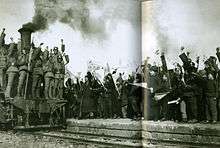
Yan was aware of the threat posed by the Japanese; and, in order to defend against the impending Japanese invasion of Shanxi, Yan entered into a secret "united front" agreement with the Communists in November 1936. After concluding his alliance with the Communists, he allowed agents under Zhou Enlai to establish a secret headquarters in Taiyuan.[19] Yan, under the slogan "resistance against the enemy and defense of the soil", attempted to recruit young patriotic intellectuals to his government from across China. By 1936 Taiyuan became a gathering point for anti-Japanese intellectuals who had fled from Beijing, Tianjin, and Northeast China.[20] A representative of the Japanese army, speaking of the final defense of Taiyuan, said that "nowhere in China have the Chinese fought so obstinately".[21]
From the Japanese occupation of Taiyuan to the Japanese surrender in 1945, the Japanese continued to exploit Taiyuan's industries and resources to supply the Japanese army. After the Japanese army in Shanxi surrendered to Yan Xishan, 10,000–15,000 Japanese troops, including both enlisted men and officers, decided to fight for Yan rather than return to Japan. Yan also retained the services of experienced and foreign-educated Japanese technicians and professional staff brought into Taiyuan by the Japanese to run the complex of industries that they had developed around Taiyuan.[22]

Taiyuan was the last area in Shanxi to resist Communist control during the final stages of the Chinese Civil War. The city was taken by the Communists on April 22, 1949, after they surrounded Taiyuan and cut it off from all means of land and air supply, and taking the city required the support of 1,300 pieces of artillery.[23] Many Nationalist officers committed suicide when the city fell.[24]
Geography
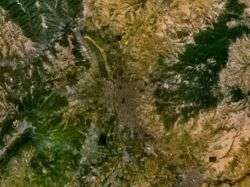
Taiyuan lies on the Fen River in the north of its fertile upper basin. The city is located at the center of the province with an East-West span of 144 km (89 mi) and a North-South span of 107 km (66 mi).[2][25] It commands the north-south route through the province, as well as important natural lines of transportation through the Taihang Mountains to Hebei in the east and to northern Shaanxi in the west.
Natural resources
Taiyuan is abundant in natural resources such as coal, iron, marble, silica, bauxite, limestone, graphite, quartz, phosphorus, gypsum, mica, copper, gold and so on. It boosts high production of coal, iron, silica and marble. The western satellite city of Gujiao is the largest production cite of coking coal (metallurgical coal) in China. The tree population in Taiyuan is dominated by coniferous forest, pine, white pine, spruce, and cypress. [26]
Climate
Taiyuan experiences a cold semi-arid climate (Köppen climate classification BSk). Spring is dry, with occasional dust storms, followed by early summer heat waves. Summer tends to be warm to hot with most of the year's rainfall concentrated in July and August. Winter is long and cold, but dry and sunny. Because of the aridity, there tends to be considerable diurnal variation in temperature, except during the summer. The weather is much cooler than comparable-latitude cities, such as Shijiazhuang, due to the moderately high altitude. The monthly 24-hour average temperature range from −5.5 °C (22.1 °F) in January to 23.4 °C (74.1 °F) in July, while the annual mean is 9.96 °C (49.9 °F). With monthly percent possible sunshine ranging from 51 percent in July to 61 percent in May, there are 2,502 hours of sunshine annually.
| Climate data for Taiyuan (1971–2000) | |||||||||||||
|---|---|---|---|---|---|---|---|---|---|---|---|---|---|
| Month | Jan | Feb | Mar | Apr | May | Jun | Jul | Aug | Sep | Oct | Nov | Dec | Year |
| Average high °C (°F) | 1.8 (35.2) |
5.4 (41.7) |
11.5 (52.7) |
19.8 (67.6) |
25.5 (77.9) |
28.6 (83.5) |
29.3 (84.7) |
28.0 (82.4) |
23.7 (74.7) |
17.8 (64) |
9.5 (49.1) |
3.1 (37.6) |
17.0 (62.6) |
| Average low °C (°F) | −11.6 (11.1) |
−8 (18) |
−2 (28) |
4.8 (40.6) |
10.5 (50.9) |
15.1 (59.2) |
18.2 (64.8) |
16.9 (62.4) |
10.8 (51.4) |
4.0 (39.2) |
−2.7 (27.1) |
−9.2 (15.4) |
3.9 (39) |
| Average precipitation mm (inches) | 3.2 (0.126) |
5.2 (0.205) |
13.4 (0.528) |
19.9 (0.783) |
33.3 (1.311) |
55.9 (2.201) |
102.1 (4.02) |
107.0 (4.213) |
51.6 (2.031) |
25.6 (1.008) |
10.7 (0.421) |
3.2 (0.126) |
431.1 (16.973) |
| Average precipitation days (≥ 0.1 mm) | 1.9 | 2.9 | 4.4 | 4.3 | 5.7 | 9.3 | 12.4 | 11.2 | 8.1 | 5.4 | 3.3 | 1.4 | 70.3 |
| Average relative humidity (%) | 50 | 47 | 50 | 47 | 50 | 61 | 73 | 77 | 74 | 67 | 62 | 56 | 60 |
| Mean monthly sunshine hours | 173.4 | 174.0 | 202.3 | 229.8 | 265.1 | 250.9 | 228.6 | 223.8 | 209.6 | 206.9 | 174.6 | 162.6 | 2,501.6 |
| Percent possible sunshine | 57 | 58 | 55 | 59 | 61 | 57 | 51 | 53 | 56 | 60 | 57 | 55 | 57 |
| Source: China Meteorological Administration[27] | |||||||||||||
Environment
The municipality of Taiyuan is 6,988 km2 (2,698 sq mi). Taiyuan has a forest area of 146,700 hectares. and total grassland area of 422.5 km2 (163.1 sq mi) in 2007.[28] The forest area coverage rate in the six urban districts has been increased to 21.69% in 2015.[29]
Taiyuan had suffered from severe air pollution, especially in the 1990s, and the first decade of the 21st century,[30] and once it was even listed among one of ten most air polluted cities in the world.[31] Recently, the air quality has been gradually improved with increasing public awareness of air quality control and stricter and more detailed rules for pollution applied. However, according to the 2014 statistical book issued by the National Bureau of Statistics, even though no longer among the worst polluted cities in China, Taiyuan still has below-average ambient air quality, compared with other major Chinese cities.[32]
Administrative divisions
| Map | ||||||
|---|---|---|---|---|---|---|
| Name | Simplified Chinese | Hanyu Pinyin | Population (2010) | Area (km²) | Density (/km²) | |
| City Proper | ||||||
| Xiaodian District | 小店区 | Xiǎodiàn Qū | 804,537 | 290 | 2,774 | |
| Yingze District | 迎泽区 | Yíngzé Qū | 592,007 | 105 | 5,638 | |
| Xinghualing District | 杏花岭区 | Xìnghuālǐng Qū | 643,584 | 146 | 4,408 | |
| Suburban | ||||||
| Jiancaoping District | 尖草坪区 | Jiāncǎopíng Qū | 415,705 | 296 | 1,404 | |
| Wanbailin District | 万柏林区 | Wànbǎilín Qū | 749,255 | 289 | 2,592 | |
| Jinyuan District | 晋源区 | Jìnyuán Qū | 221,431 | 290 | 763 | |
| Satellite cities | ||||||
| Gujiao City | 古交市 | Gǔjiāo Shì | 205,143 | 1,512 | 135 | |
| Rural | ||||||
| Qingxu County | 清徐县 | Qīngxú Xiàn | 343,861 | 608 | 565 | |
| Yangqu County | 阳曲县 | Yángqǔ Xiàn | 120,228 | 2,084 | 57 | |
| Loufan County | 娄烦县 | Lóufán Xiàn | 105,841 | 1,289 | 82 | |
Demographics
At the 2010 census, Taiyuan prefecture had a total population of 4,201,591 inhabitants on 6,959 km2 (2,687 sq mi), from whom 3,212,500 are urban on 1,460 km2 (560 sq mi).[1]
Economy
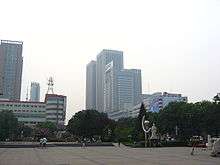
In 2015, Taiyuan's nominal GDP was around 290 billion yuan, or 44.5 billion USD, a growth of 8.1 percent from the previous year.[33] Taiyuan's primary, secondary, and tertiary industries were worth 3.9 billion yuan, 105.2 billion yuan, and 132.2 billion yuan respectively in 2007. [33] The Shanxi produces a quarter of China's coal, and Taiyuan is the location of the China Taiyuan Coal Transaction Center, which began trading in 2012.[34]
Transportation
Taiyuan is one of the transportation hubs in North China, with highways linking neighboring provincial capitals, and airlines to most other major Chinese cities and some international cities.
Public Transportation
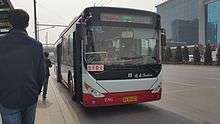
The Taiyuan Metro is under construction, and is expected to start operation around 2020.
In early 2016 the city began the conversion of all its 8000 taxi fleet into purely electric vehicles, initially using BYD Auto model E6.[35][36]
Air
.jpg)
The primary airport of the city is Taiyuan Wusu Airport. It has been expanded for the landing of Airbus A380. The airport has domestic airlines to major cities including Beijing, Shanghai, and coastal cities such as Dalian.[37] International flights to Taipei and Da Nang are available.[38][39]
Highway
Taiyuan has a number of major roads, Including the G5, G20 (including Shitai Expressway), G55, G2001 (Ring Highway around Taiyuan), G307, G108, G208.
- A 45-kilometer Middle Ring Highway circles the metropolis of Taiyuan.
- Two highways on the banks of Fen River run through the center of the city.
- Nine Riverside highways along the nine branches of Fen River, including the Southern Shahe river, Northern Shahe river, etc, comprise an expressway system, connecting the central Fen River bank with surrounding areas of urban Taiyuan.
- The southern part of Taiyuan has three "East-West" direction highways: South Middle Ring Street, Huazhang Street and Yingbin Road, and five "North-South" direction highways: West Middle Ring Road,Binhe West Road, Binhe East Road, Dayun Road, Jianshe Road & Taiyu Road.
- The western S56 Taiyuan-Gujiao Highway links Taiyuan with the western satellite city of Gujiao, and further connects Loufan.
- The northern Yangxing Highway connects downtown Taiyuan with the northern suburb of Yangqu County.
Railway
.jpg)
Taiyuan is one of the main national hubs for the high-speed railway system of Northern China. Major high-speed railways passing Taiyuan, including the Shijiazhuang–Taiyuan High-Speed Railway and Datong–Xi'an passenger railway. By high-speed trains, the travel time between Taiyuan and Beijing is less than three hours on a distance of 600 km (370 mi).[40] The main high-speed railway station is Taiyuan Nan (Taiyuan South) station. The conventional-speed Taiyuan–Zhongwei–Yinchuan Railway, opened in 2011, provides a direct connection with western Shanxi, northern Shaanxi, Ningxia, and points further west.
Food
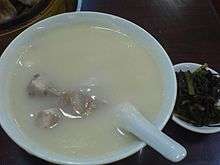
Taiyuan's local specialities include:
- Tomato egg noodles (Chinese: 西红柿炒鸡蛋面; pinyin: xīhóngshì chǎo jīdàn miàn; literally: "noodles with tomato and scrambled eggs")
- Tijian (Chinese: 剔尖; pinyin: tī jiān; literally: "scraped noodles")
- Dao Xiao noodles (Chinese: 刀削面; pinyin: dāo xiāo miàn)
- Tounao (Chinese: 头脑; pinyin: tóu nǎo; literally: "brain-enhancing soup"): Contains mutton, rice wine and vegetables in the soup. This dish was first created by Chinese polymath Fu Shan, who was proficient in medicine, for his old and illness-ridden mother as a food substitute for the ancient medicine Bazhen Tang (literally "Soup of Eight Treasures") using only locally available food materials that have similar effects as the original medicine.[41]
- Lao Chen Cu mature vinegar (Chinese: 老陈醋; pinyin: lǎo chén cù)
- Yuci Flour Sausage (Chinese: 榆次灌肠; pinyin: Yú Cì guàn cháng)
- Fried Pork with vegetables (Chinese: 过油肉; pinyin: guò yóu ròu)
- Mutton Soup (Chinese: 羊肉汤; pinyin: yángròu tāng)
Tourism
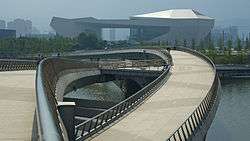
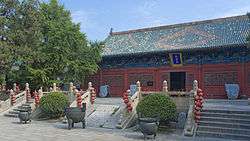

Taiyuan is a modern city with just a few historic buildings remaining in the centre. The remnants of old Taiyuan can be found west of the central station, north of Fudong Street and close to Wuyi Road.
One of the main tourist destinations is Shanxi Museum located in West Binhe Road, downtown Taiyuan, which is among the largest museums in China.
The Twin Towers in Yongzuo Temple, which are featured in the emblem of the city, have been regarded as a symbol of Taiyuan for a long time. Yongzuo Temple is at southeast of the city centre, also famous for its peony garden and martyrs cemetery.
The Chongshan Monastery, Longtan Park, and Yingze Park, in the city centre, are popular tourist destinations.[42]
Jinci Temple also called Tangshuyu Temple, located in Jinyuan District of southern Taiyuan, dates back to the Zhou Dynasty. In Jinci, there are three treasures: the Nanlao Spring, the Beauty Status and the Queen status. The Flying Bridge Across the Fish Pond was built during the Song Dynasty, which is famous for its cross-shaped structure.[43]
Along the West Mountain range in western Taiyuan, tourists can find Tianlongshan Grottoes, which were gradually built over many centuries, from the northern Qi dynasty, and contains thousands of Buddhist statues and artwork. The grottoes exist today in a damaged state with many of the sculptures now missing, that visitors to the caves cannot imagine how they looked in the past. Many of the sculptures from the caves are now in museums around the world. However, though the sculptures may be preserved and displayed, visitors to museums cannot understand them in their original historical, spatial, and religious contexts. Researchers at the University of Chicago initiated the Tianlongshan Caves Project in 2013 to pursue research and digital imaging of the caves and their sculptures.[44]
Not far from the Tianlongshan Grottoes are the Longshan Grottoes, which is the only Taoist grottoes site in China. The main eight grottoes were carved in 1234~1239 during the Yuan Dynasty.
Education
Major schools
- Taiyuan Yuying Secondary School(育英中学)
- The Affiliated High School of Shanxi University(山西大学附属中学)
- Shanxi Experimental Secondary School(山西省实验中学)
- Taiyuan Foreign Language School(太原市外国语学校)
- Taiyuan No. 5 Secondary School(太原五中)
- Taiyuan No. 12 Secondary School(太原十二中)
- Taiyuan Second Foreign Language School(太原市第二外国语学校)
Colleges and universities
See also
International relations
Taiyuan has a friendship pairing with the following cities:[45][46][47]










References
- 1 2 "山西省2010年第六次全国人口普查主要数据公报(Sixth National Population Census of the People's Republic of China" (in Chinese). National Bureau of Statistics of China. Archived from the original on 17 April 2013. Retrieved 2 June 2015.
- 1 2 "Archived copy" 太原市. www.shanxigov.cn (in Chinese). Shanxi People's Government. 26 October 2012. Archived from the original on 24 September 2015. Retrieved 23 July 2015.
- ↑ "Illuminating China's Provinces, Municipalities and Autonomous Regions". PRC Central Government Official Website. Retrieved 2014-05-17.
- 1 2 3 历史沿革. Taiyuan People's Government. (in Chinese)
- 1 2 汉典-三京.
- 1 2 先秦史籍中的"太原" (in Chinese)
- ↑ 太原指南 (in Chinese)
- ↑ Sima Qian vol. 43 司马迁 史记 卷43
- 1 2 Government of Taiyuan. "Archived copy" 历史沿革 (in Chinese). Archived from the original on 24 September 2015. Retrieved 26 August 2015.
- ↑ 资治通鉴 唐纪三 司马光
- 1 2 3 4 A. D. Levine, The Reigns of Hui-tsung (1100–1126) and Ch’in-tsung (1126–1127) and the Fall of the Northern Sung, in P. J. Smith (ed.), The Cambridge History of China, vol. 5, Part One: The Sung Dynasty and Its Precursors, 907–1279, (Cambridge University Press, Cambridge, 1994), Ch. 7. ISBN 978-0-521-81248-1
- ↑ "宋太宗平毁太原 盗墓史上那些挖别人祖坟的事(4)". Archived from the original on 18 July 2011. Retrieved 25 October 2009.
- ↑ R. Dunnel, The Hia Hia, in D. Twitchet and J. K. Fairbank (eds.), The Cambridge History of China, vol. 6, Alien Regimes and Border States, 907—1368 (Cambridge University Press, Cambridge, 1994), p. 178 ISBN 978-0-521-24331-5
- ↑ P. J. Smith, Shen-tsung’s Reign and the New Policies of Wang An-shih, 1067–1085, in P. J. Smith (ed.), The Cambridge History of China, vol. 5, Part One: The Sung Dynasty and Its Precursors, 907–1279, (Cambridge University Press, Cambridge, 1994), p. 357. ISBN 978-0-521-81248-1
- ↑ Shanxi Provincial Academy of Social Sciences, ed., Shanxi piaohao shiliao (山西票号史料) (Taiyuan: Shanxi jingji chubanshe, 1992), pp. 36-39.
- ↑ History of banking in China
- ↑ Roger R. Thompson (2007). "Reporting the Taiyuan Massacre: Culture and Politics in the China War of 1900". In Robert Bickers and R.G. Tiedemann. The Boxers, China, and the World. Rowman & Littlefield.
- ↑ Gillin, Donald G. "Portrait of a Warlord: Yen Hsi-shan in Shansi Province, 1911-1930." The Journal of Asian Studies. Vol. 19, No. 3, May, 1960. Retrieved February 23, 2011. pp.289-294.
- ↑ Gillin, Donald G. Warlord: Yen Hsi-shan in Shansi Province 1911-1949. Princeton, New Jersey: Princeton University Press. 1967. p.263.
- ↑ Feng Chongyi and Goodman, David S. G., eds. North China at War: The Social Ecology of Revolution, 1937-1945. Lanham, Maryland: Rowman and Littlefield. 2000. ISBN 0-8476-9938-2. Retrieved June 3, 2012. pp.157-158
- ↑ Gillin, Donald G. Warlord: Yen Hsi-shan in Shansi Province 1911-1949. Princeton, New Jersey: Princeton University Press. 1967. pp.272–273.
- ↑ Gillin, Donald G. and Etter, Charles. "Staying On: Japanese Soldiers and Civilians in China, 1945-1949." The Journal of Asian Studies. Vol. 42, No. 3, May, 1983. Retrieved February 23, 2011. p.500, 506–508.
- ↑ Gillin, Donald G. Warlord: Yen Hsi-shan in Shansi Province 1911-1949. Princeton, New Jersey: Princeton University Press. 1967. p.288.
- ↑ Spence, Jonathan D. The Search for Modern China, W.W. Norton and Company. 1999. ISBN 0-393-97351-4. p.488
- ↑ "City of Taiyuan". People's Government of Shanxi. Archived from the original on 24 September 2015. Retrieved 23 July 2015.
- ↑ Water Pollution and Water Quality Control of Selected Chinese Reservoir Basins
- ↑ 中国地面国际交换站气候标准值月值数据集(1971-2000年) (in Chinese). China Meteorological Administration. Archived from the original on 16 October 2013. Retrieved 17 March 2009.
- ↑ Tang, Deliang; Wang, Cuicui; Nie, Jiesheng; Chen, Renjie; Niu, Qiao; Kan, Haidong; Chen, Bingheng; Perera, Frederica (2014). "Health benefits of improving air quality in Taiyuan, China". Environment International. 73: 235–242. doi:10.1016/j.envint.2014.07.016.
- ↑ 六城区森林覆盖率达21.69%. Taiyuan People's Government.
- ↑ "Ambient Air Quality in Main Cities (2004) in China Statistics 2005". Retrieved 2016-04-14.
- ↑ "WEATHER & EXTREME EVENTS 7 of 10 Most Air-Polluted Cities Are in China". JAN 16, 2013. Imaginechina/Corbis. http://news.discovery.com. Retrieved 1 September 2014.
- ↑ Ambient Air Quality in Main Cities (2013) in China Statistics 2014
- 1 2 太原市2013年国民经济和社会发展统计公报. 山西统计信息网 (in Chinese). 9 April 2014. Archived from the original on 14 July 2015. Retrieved 17 July 2015.
- ↑ "China Taiyuan coal transaction center put into operation". China.org.cn. 23 February 2012. Retrieved 10 September 2013.
- ↑ "Electric taxis on the roads in Taiyuan", www.chinadaily.com.cn, 16 Mar 2016
- ↑ "North China's Taiyuan will be first in country with only electric taxis", www.cctv-america.com, 3 Mar 2016
- ↑ 暑假去哪儿 避暑长白山 畅游沙坡头——成都航空引进全新空客飞机,恢复成都=中卫,成都=长春=长白山等航线 (in Chinese). Chengdu Airlines Co., Ltd. Retrieved 23 July 2015.
- ↑ "EVA Air/UNI Air Adds New Routes to China from July 2014". airlineroute.net. 14 May 2014. Retrieved 23 July 2015.
- ↑ "EVA Air/UNI Air Adds New Routes to China from July 2014". airlineroute.net. 18 May 2014. Retrieved 23 July 2015.
- ↑ Dingding, Xin (25 March 2009). "High-speed rails to slash travel time". China Daily. Retrieved 18 September 2010.
- ↑ 太原名吃头脑
- ↑ Taiyuan Attractions
- ↑ "Visit Jinci Temple". tour-beijing.com. Retrieved 16 October 2017.
- ↑ "Center for the Art of East Asia in the Department of Art History at the University of Chicago".
- ↑ "Foreign Exchanges". Doing Business in Shanxi. China.org.cn. Retrieved 7 April 2013.
- ↑ 国际友好城市-山西省人民政府网(International Sister Cities) (in Chinese). Shanxi People's Government. Retrieved 2017-11-17.
- ↑ 友好城市建立后咋往来 与我们的生活有啥关系 (in Chinese).
山西晚报 [Shanxi Evening News]. 2017-09-15. Retrieved 2017-11-17. templatestyles stripmarker in
|publisher=at position 1 (help) - ↑ "Jumelage entre Taiyuan et St-Denis : La Chine se rapproche un peu plus de la Réunion" (in French). Zinfos974. Retrieved 2017-11-17.
- ↑ 太原市与胡占德市结为国际友城 [Taiyuan and Khujand become sister cities] (in Chinese). Taiyuan Daily (太原日报). 2017-09-01. Retrieved 2017-11-17.
- ↑ "Sister Cities of Nashville". SCNashville.org. Retrieved August 3, 2011.
External links
| Wikimedia Commons has media related to Taiyuan. |
| Wikivoyage has a travel guide for Taiyuan. |
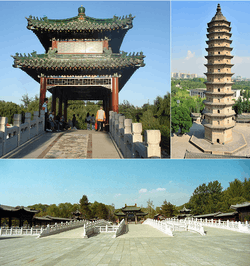
.png)
